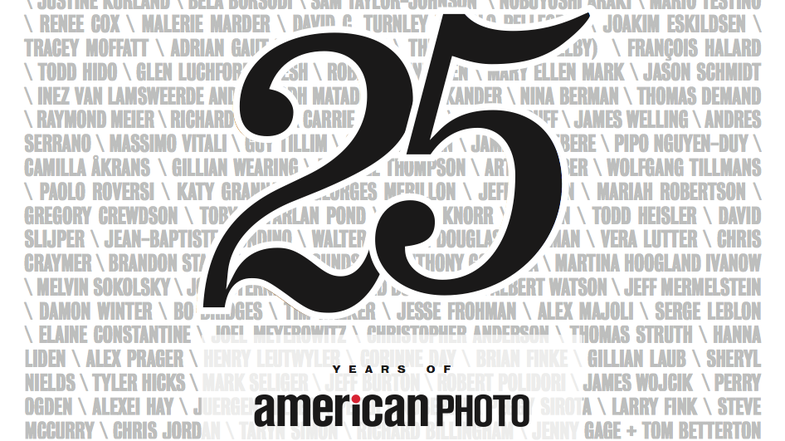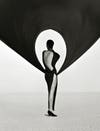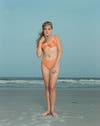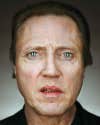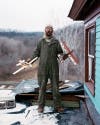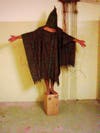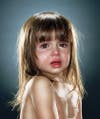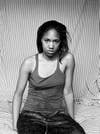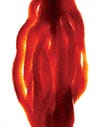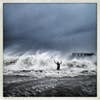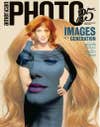Herb Ritts “Versace Dress, Back View, El Mirage,” 1990 With one foot in the aesthetic terrain of photographic forebears Richard Avedon, Irving Penn, and Robert Mapplethorpe, Ritts planted a new flag at the intersection of fashion, celebrity portraiture, and art. This monumental photo of supermodel Christy Turlington, her dress tied up on light stands and catching the wind before a storm, ushered in the 1990s with a singular vision that only seems stronger in the rearview mirror. © Herb Ritts—Trunk Archive Catherine Opie “Bo,” 1991 Being and Having, Opie’s first solo exhibition at New York City’s Gallery 494, knocked the art world on its ear. The series of studio portraits (this one is of herself) was a landmark in its exploration and celebration of queer identity. © Catherine Opie—Regen Projects, Los Angeles Rineke Dijkstra “Hilton Head Island, S.C., USA,” 1992 In her Beach Portraits series, Dijkstra’s cool and empathic lens captured youth on the shores across the globe and influenced scores of portrait photographers. © Rineke Dijkstra—Marian Goodman Gallery, New York Thomas Demand “Sprungturm (Diving Platform),” 1994 A photographer originally trained as a sculptor, Demand builds life-size models of architectural spaces (often those he has seen in pictures) out of paper and then photographs them. Look closely and you’ll see that, like photography itself, there’s more to be understood than what you notice at first glance. © Thomas Demand—Artists Rights Society (ARS), 2014/Courtesy of Sprüth Magers, Berlin & London Sebastião Salgado “Churchgate Station, Western Railroad Line, Bombay, India,” 1995 This British-built station is notorious for its dangerous crowds, and it was in politically and emotionally loaded locations such as this that Salgado focused his seminal late 20th-century photography, eventually published in Migrations: Humanity in Transition (Aperture, 2000). © Sebastião Salgado—Amazonas/Contact Press Images Dawoud Bey “Toyia, Kelvin and Erica,” 1996 Shooting with a large-format Polaroid camera, Bey continued the work that would become a large part of his early career: making beautiful, respectful, and monumental portraits of adolescents, most of them minorities. © Dawoud Bey—Courtesy of Bank of America Collection David Lachappele “This Is My House,” 1997 (Alek Wek in Christian Lacroix, New York, for Paris Vogue ) LaChapelle’s vivaciousness and intensity were unmatched in the late 1990s; his grand-scale concepts and productions pushed the limits of what viewers expected from photography. © David LaChapelle—Creative Exchange Agency, New York
Teen Brain, Girl Culture
Lauren Greenfield “Sheena Tries On Clothes with Amber, 15, in a Department Store Dressing Room, San Jose, California,” 1999 Moving beyond the Hollywood teens that Greenfield chronicled in her first major work, she began exploring the effects of consumer culture on young women; this image became part of Girl Culture (Chronicle Books, 2002). Her politically suffused documentary style was as refreshing as it was artful.
Martin Schoeller “Christopher Walken,” 2000 (for Entertainment Weekly ) It was around the turn of the millennium that Schoeller’s sometimes larger-than-life heads, captured with technical precision and fine detail, showed us a shockingly honest view of our most famous citizens, including actor Christopher Walken, shown here. Schoeller’s recent volume, Portraits , was one of our Best Books of 2014 . © Martin Schoeller—AUGUST Gregory Crewdson “Untitled,” 2001 This image comes from the Twilight series (1998-2002), exhibited first at the White Cube gallery in London. It exemplifies his highly influential cinematic style of “frozen moments,” managing and lighting each of his haunting, mythical still scenes as one would a feature film. © Gregory Crewdson—Courtesy Gagosian Gallery Alec Soth “Charles, Vasa, Minnesota,” 2002 Compared to the likes of Walker Evans and Robert Frank, Soth created his debut work, Sleeping by the Mississippi, by doing just that. His photos resisted narrative but caught the imagination of a nation examining itself in a post-9/11 world. © Alec Soth
ABU GHRAIB PRISON
Abu Ghraib, 2004 One of many pictures taken by U.S. military personnel in the Abu Ghraib prison in Iraq, this image of an Iraqi prisoner under torture startled the world and became a potent symbol of the abuse of prisoners by U.S. forces.
Edward Burtynsky “Dam #6, Three Gorges Dam Project, Yangtze River,” 2005 Burtynsky documents the impact of industry on the landscape. The photographs he made in the People’s Republic of China, like this seminal view inside one of the world’s largest public works projects, open a window on the realities underlying globalization. © Edward Burtynsky—Nicholas Metivier Gallery, Toronto/Howard Greenberg Gallery/Bryce Wolkowitz Gallery, New York Jill Greenberg “Earth,” 2006 Greenberg’s series End Times was a commentary on the politics of the Bush administration. First shown at the Kopeikin Gallery in Los Angeles in 2006, the work incited rage among some viewers and spawned a huge group of aesthetic imitators. © Jill Greenberg—ClampArt Chris McCaw “Sunburned GSP#166 (Mojave/Winter Solstice full day),” 2007 McCaw started experimenting with the effects of sun exposure on photo paper in 2003, but this piece marks both his first sunrise-to-sunset capture and his first multiple-panel piece. © Chris McCaw (collection of the Metropolitan Museum of Art, New York) Tim Hetherington “Kunar Province Afghanistan, Korengal Valley,” 2008 British-born Hetherington may be best known now for Restrepo, the 2010 film he made with Sebastian Junger, and for his death by mortar fire in Libya in 2011. But it was the intimate scenes he captured while embedded with U.S. forces in 2007 and 2008 that set him apart. © Tim Hetherington—Magnum Photos LaToya Ruby Frazier “Self Portrait, March (10am),” 2009 In this self-portrait taken during a lupus attack, Frazier poses in her late grandmother’s silk pajama pants in front of a sheet. As in this image, Frazier’s moving work, much of it focused on her family and her post-industrial hometown of Braddock, Pennsylvania, sits at the intersection of the personal and the political. It was recently published in the artist’s first monograph, The Notion of Family © LaToya Ruby Frazier—Michel Rein, Paris/Brussels Mitchell Feinberg “Untitled,” 2010 (for Women’s Health magazine) Specializing in lushness and luxury, yet able to find new ways to capture the familiar, Feinberg is a still-life master whose incredible images have inspired countless photographers. © Mitchell Feinberg Pari Dukovic “Bernadette Peters backstage at the Marriott Marquis,” 2011 (for New York magazine) Dukovic gets magic out of his subjects. A portraitist who follows in the footsteps of Richard Avedon and others, he is now The New Yorker ‘s staff photographer. When he shot this early in his career, his images already bore their distinct palette and style, in which gesture is almost as important as detail. © Pari Dukovic—Trunk Archive
NYC: Superstorm Sandy
Benjamin Lowy “Superstorm Sandy makes landfall near Coney Island, NY, October 29,” 2012 When Superstorm Sandy hit the Eastern seaboard in 2012, Lowy was there with his camera phone. Known for his Instagram journalism, he scored the first smartphone shot ever published on the November 12 cover of Time magazine.
Carlos Serrao “Kenneth Faried,” 2013 (for ESPN, The Magazine’s Body Issue) Carlos Serrao is noted for his sports photography, to which he brings a cinematic, often fashion-y edge. His work for ESPN—including this image of Kenneth Faried of the Denver Nuggets—captured the bodies of athletes with an aesthetic that harkens back to ancient Greek sculpture, but adds contemporary dynamism and flair. © Carlos Serrao Launched in its current incarnation in 1990, American Photo’s existence parallels a time of incredible transformation in photography. The birth of digital changed the way images were made, and then the Internet and, later, social media transformed the way images were shared. Bigger pictures made their way into big museums, while little ones exploded in the devices in our pockets. Editorial budgets shrank and stalwart magazines disappeared. The last roll of Kodachrome was shot. Despite—or perhaps because of—all of this change, photography is as alive as ever. Here’s our look at the past 25 years in pictures: the images of a generation.
Cover image by Peter Hapak
